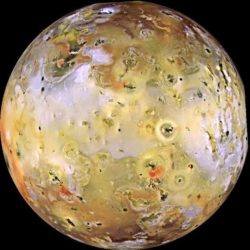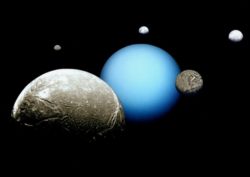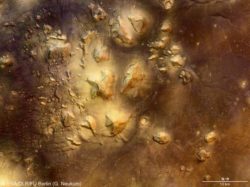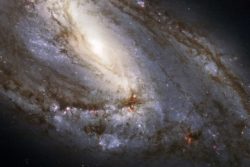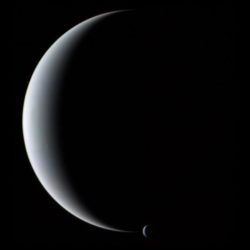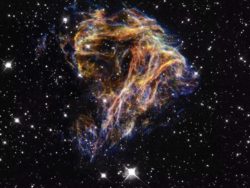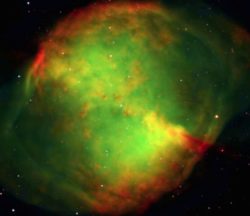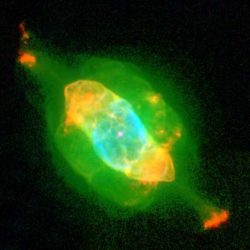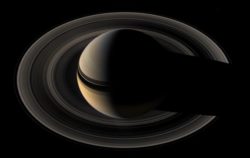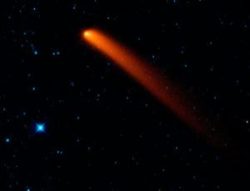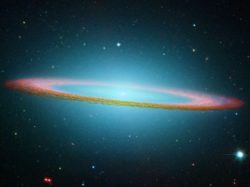Astronomy Picture of the Week – Io Moon Of Jupiter
Io is the most volcanically active body in the solar system. It is the innermost of Jupiter's four major moons also known as the Galilean moons, named after their discoverer. Io's surface is constantly under construction. The volcanic eruptions quickly reshape every part of the moon's crust, so that a map of Io wouldn't stay accurate for quite long.
Astronomy Picture of the Week – Planet Uranus with Moons
This is a photo montage of Uranus and five of it's largest moons. The photos were taken separately by the Voyager 2 spacecraft. The moons, from largest to smallest as they appear here, are Ariel, Miranda, Titania, Oberon and Umbriel. When Voyager 2 visited the planet, it discovered 10 new smaller moons and took close-up pictures of its ring system.
Astronomy Picture of the Week – Stone Mesas of the Cydonia Region on Mars
This photo of the unusual stone mesas of the Cydonia region on Mars was taken by the robotic spacecraft called Mars Express. It shows an area about 90 kilometers wide. What most people don't know is that the region in the far lower right of this photo is the same region in which the Viking orbiter saw a human face in 1976.
Astronomy Picture of the Week – Unusual Spiral Galaxy M66
This is a photo of an unusual spiral galaxy called M66, or NGC 3627, taken by the Hubble Telescope. It lies about 35 million light years from Earth and it spans 100,000 light years. At a first glance, this galaxy looks familiar. Why? Well, because it is similar to our own galaxy, the Milky Way. Both galaxies are spirals. However, what’s really unusual about this one is that it is asymmetric. Usually the force of gravity of a mega black hole (or group of mega black holes) attracts all the stars and interstellar gas in a symmetric pattern. If the mega black hole is not originally in the center of…
Astronomy Picture of the Week – Crescent Neptune and Triton
This is a photo of a crescent Neptune and its largest moon Triton taken by the Voyager 2 probe in 1989. It is unique because such a picture could not be taken from Earth since Neptune never shows a crescent phase to sunward Earth.
Astronomy Picture of the Week – Jupiter from Voyager
This photo of Jupiter featuring the Great Red Spot was taken by the Voyager 1 spacecraft as it flew-by the planet in 1979. The Great Red Spot is a giant hurricane-like storm rotating in the planet's atmosphere. It is so large that three Earth's would fit inside. It is still unclear as to how old this storm is, since it was first recorded by astronomers over 300 years ago, suggesting that it could be much older than that. How it managed to remain active for that long still remains a mystery.
Astronomy Picture of the Week – Distant Nebula
This nebula, designated as N 49 or DEM L 190, looks like puffs of smoke or sparks from a fireworks display. It is one of the most distant nebulae ever observed, located in the Large Magellanic Cloud, a dwarf galaxy orbiting the Milky Way. The nebula is the result of a large supernova, whose light should have reached Earth a few thousand years ago.
Astronomy Picture of the Week – M27 Or Dumbbell Nebula
This greenish nebula was discovered by Charles Messier, a French astronomer of the 18th century. Originally he did not know what the object was, except that it was neither a star nor a comet. Now we know that it is a planetary nebula. It was formed by the explosion of a sun-like star (nova). It is officially designated as Messier 27 (M27, or NGC 6853), while it is commonly known as the Dumbbell Nebula. This beautiful nebula is located over 1,200 light-years away in the Vulpecula constellation. Image Credits: ESO, the European Southern Observatory.
Astronomy Picture of the Week – Nebula NGC 7009
This odd greenish nebula, called NGC 7009 or the Saturn Nebula, is the result of a star similar to our sun going nova. Since then, a bright new star was born from the gases of its predecessor. It can be seen in the center of the nebula, inside the bluish sphere of gas. The nebula is located 1,400 light-years away in the constellation of Aquarius. The picture was taken by the Hubble Space Telescope. Image Credits: NASA and Hubble Space Telescope
Astronomy Picture of the Week – The Rings of Saturn
This picture of Saturn’s rings in its natural colors has been taken by the Cassini probe from an angle impossible to get from Earth. We can see a huge gap in Saturn’s rings. This is caused by the planet obscuring the Sun’s light. Since the rings do not emit light on their own, a lack of sunlight would mean no reflected light, and thus they would remain dark. The rings are also projecting a shade on the planet near the equator for similar reasons, except here the roles are reversed. Saturn’s Rings by Cassini. Image credits: NASA/ESA
Dark Asteroids Discovered, Possible Threat to Earth
Dark asteroids near Earth, hard to spot but potential threats. WISE infrared telescope helps detect them. What's the risk of asteroid impact?
Astronomy Picture of the Week – Sombrero Galaxy
This stunning picture of the Sombrero Galaxy in infrared was taken by the Spitzer Space Telescope. The Sombrero Galaxy, also known as M104, is 50,000 light years across which makes it one of the largest galaxies of the Virgo Cluster of Galaxies. It is 28 million light years away from us.

